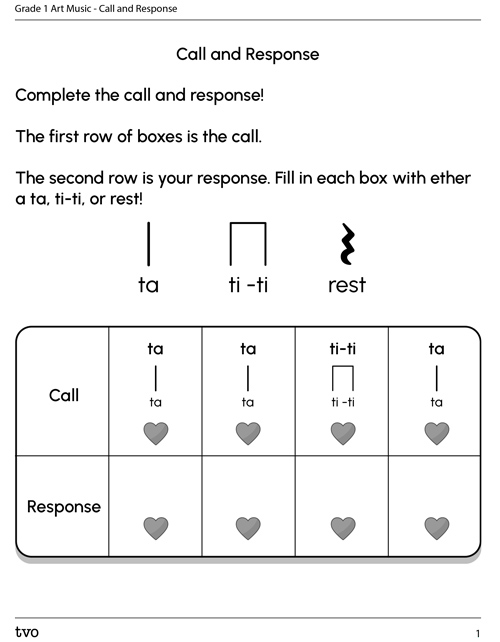Minds On
Today’s vocabulary
A pattern of long and short sounds or silences. Rhythm is different from beat; for example, the rhythm at the beginning of a song might be “ta, ta, ti-ti, ta”. The beat is the steady pulse of “ta, ta, ta, ta”. Explore also beat.
A steady and repeating pulse in music. Part of the element of duration.
A note that is held for one beat.
A note that is held for one-half of a beat. Beams can connect eighth notes.
Indicates a period of silence lasting one beat.
A song or rhythmic pattern that has a “call” section sung or played by a leader and a “response” section sung or played by an individual or group. Explore also echo singing.
Let’s get started!
Let’s play a word game.
Teacher A is going to start a word phrase. Your task is to finish the phrase with a word.
You can access the audio clip of Teacher A’s phrase or explore the image.
Word Game

Pause and Reflect
What do you say?
Teacher A began with “Ready … set …”
Some people said “go!” and others said “begin.”
What do you say?
Let’s play again.
This time, Teacher B is going to help.
Teacher A will start speaking and Teacher B will finish the thought. They will go back and forth!
You can access the audio clip or explore the image of Teacher A and B talking.
Teacher A and B Word Game

We made a song that had a pattern. First a question and then an answer. This kind of song is called a call and response.
Now you try!
Here’s the pattern again. This time, respond to each thing that is said:
Word Game

My turn: I like playing…
Your turn: (Name a game you like to play such as hopscotch, hide-and-seek, marbles, or leapfrog).
My turn: I play it…
Your turn: (How often to you play this game? Everyday? Twice a day? Once a week?)
My turn: I like playing…
Your turn: (Repeat the name of a game you like to play such as hopscotch, hide-and-seek, marbles, or leapfrog).
Together: So, let’s go play, play, play!
Great job! You helped with a call and response!
Action
Get ready, get set…
What is call and response?
A call and response song has two different parts. The call and the response.
It’s like a conversation or a follow-the-leader activity. It’s like a question and an answer.
A steady beat helps the call and response.
Here is an example of call and response. The call is first. The response is next.
Call and Response Example
Here is the same call and response in a chart:

There is a row called Call.
There are four boxes in the row.
The next row is called Response.
There are four boxes in the row.
A beat chart with two rows, with the first row representing the call and the second row representing the response. Hearts represent the beats, while a single vertical line represents "ta" and a double vertical line with a connecting bar at the top represents "ti-ti". The call is: ta, ta, ti-ti, ta. The response is ta, ta, ta, ta.
Your turn!
Let’s explore three more examples of call and response!
Some of these examples use rests.
A rest is a silent beat. Instead of clapping, put your hands out to the side on a rest.

If possible, clap, tap, or speak along with the rhythm.
Call and Response 1
Here is the same call and response in a chart:

There is a row called Call.
There are four boxes in the row.
The next row is called Response.
There are four boxes in the row.
A beat chart with two rows, with the first row representing the call and the second row representing the response. Hearts represent the beats, a single vertical line represents "ta", a double vertical line with a connecting bar at the top represents "ti-ti", and a squiggle represents a rest. The call is: ta, ta, ti-ti, ta. The response is ta, rest, ti-ti, ta.
Great work! Let’s explore another example.
If possible, clap, tap, or speak along with the rhythm.
Call and Response 2
Here is the same call and response in a chart:

There is a row called Call.
There are four boxes in the row.
The next row is called Response.
There are four boxes in the row.
A beat chart with two rows, with the first row representing the call and the second row representing the response. Hearts represent the beats, a single vertical line represents "ta", and a squiggle represents a rest. The call is: ta, rest, ta, rest. The response is ta, ta, ta, ta.
Great work! Let’s explore one more call and response!
If possible, clap, tap, or speak along with the rhythm.
Call and Response 3
Here is the same call and response in a chart:

There is a row called Call.
There are four boxes in the row.
The next row is called Response.
There are four boxes in the row.
A beat chart with two rows, with the first row representing the call and the second row representing the response. Hearts represent the beats, a single vertical line represents "ta", a double vertical line with a connecting bar at the top represents "ti-ti", and a squiggle represents a rest. The call is: ta, rest, ta, rest. The response is ti-ti, rest, ti-ti, rest.
Go!
Explore the following call from Teacher A:

Here is an audio version of Teacher A’s call:
Teacher A Call
How would you respond to Teacher A’s call?
Create your response using the following interactive chart!
Add tas, ti-ti’s or rests in the four “response” boxes.
Keep in mind that your response should be different from the call!
You can also complete this activity by using the following fillable and printable Call and Response document.
Try It
Try it
If possible, try to clap, tap, or speak your call and response together.
Try it again.
This time, use ta, ti-ti, and rest in a different way!
Portfolio
Portfolio
Consider adding your call and response to your portfolio.
Consolidation
Putting it all together

Today you created a four-beat rhythm response to a call.
Answer the following questions about your experience.
- Did you use ta, ti-ti, and/or rest?
- What was the most important or memorable thing you experienced in this learning activity? What do want to continue to practice?
Tell me about it
Share what you learned about today using the words ta, ti-ti, and rest.
You can choose to:
- draw and label the important parts using the words ta, ti-ti, and rest
- tell someone using the words ta, ti-ti, and rest
- write about it using the words ta, ti-ti, and rest
- make a recording using the ta, ti-ti, and rest
Reflection
How do you feel about what you have learned in this activity? Which of the next four sentences best matches how you are feeling about your learning? Press the button that is beside this sentence.
I feel…
Now, record your ideas about your feelings using a voice recorder, speech-to-text, or writing tool.
